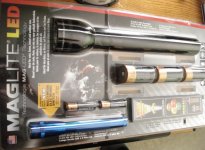The following is personal opinion based on experices over the last 35+ years.
Surefire & other "tactical lights" serve two primary functions - illumination and visually impairing the target/suspect. The ultra bright lamps do both these functions very well. Their small size and relative light weight, combined with a momentary on/off switch (usually in the tailcap) means they're easy and convenient to use with a handgun. As an impact weapon, I'd rate them as poor simply because they lack reach and mass.
Maglites & other heavy duty aluminum lights serve several functions, depending on size. The heavier aircraft aluminum bodies can serve as impact weapons in a close quarters fight. They're usually bright enough to cause the target/suspect to squint or avert looking in the direction of the light. The adjustable heads on some allow a wide "search" beam or a narrow "intense" beam. Multiple battery units (over 2-cell size) supply an extended run time and add useful striking reach to the light.
C-Cell vs. D-Cell lights - Tac lights using small CR123 batteries are easy to hold in one hand. But the larger Maglight styles come in either "D" cell or "C" cell. Most common is the "D" cell. In the 60's-80's, many police used the multiple C-Cell Kel-Lite because the smaller "C" cell size allowed the flashlight to fit into a baton ring on the belt. During a fight, The longer 18-24" lights could easily be subsituted for a baton. Same techniques and similar tactics. With fresh batteries, the C-cell was just as bright as the D-cell. D-cells offered longer running time for traffic control, searching, vehicle repair, etc. The down side was they were about 15% heavier and harder to keep your grip on them.
Civilian Usage:
For the average civilian in a CCW situation, the tactical lights like "Surefire" lights offer bright illumination, blazingly blinding white light, easy use and good concealment. In plastic or aluminum, it's simply a good choice because you can always carry it alongside spare ammo or a cell phone.
For home or car use, I still prefer a 3 to 4 "C" cell light because you get more grip around the light. Unless you have the hands of an NFL linebacker, this will be critical if you use the light as a defensive impact weapon. But when selecting a light to use with a handgun, remember that the longer the light, the more difficult it will be to balance and keep the light on target. Those batteries are heavy and will pull down at the rear. Strong wrists are needed. For women and teens especially, the C-cell is the obvious choice to allow them to grip the light easily.
From experience in using them, the D-cell Maglight style lights lose their usefulness as impact weapons if you go beyond about 5-cell sizes. Too heavy to be really useful in close-in fight. All that mass & inertia will start working against you.
The longer, thinner C-cell lights that emulate a baton (6-10 cell) work well only if you know baton techniques. Yes, there's more to it that simply raining down blows on someone (aka "nine from the sky"). Otherwise stick to the 3-4 cell models.
Legal Warnings:
In some jurisdictions, if the flashlight contains a spacer that replaces battery capacity (i.e. a 4-cell light with a 6-cell length) the D.A. may classify the flashlight as a bludgeon, "nightstick" or other illegal weapon. Be sure you understand how authorities will view such a flashlight before carrying one like that.

